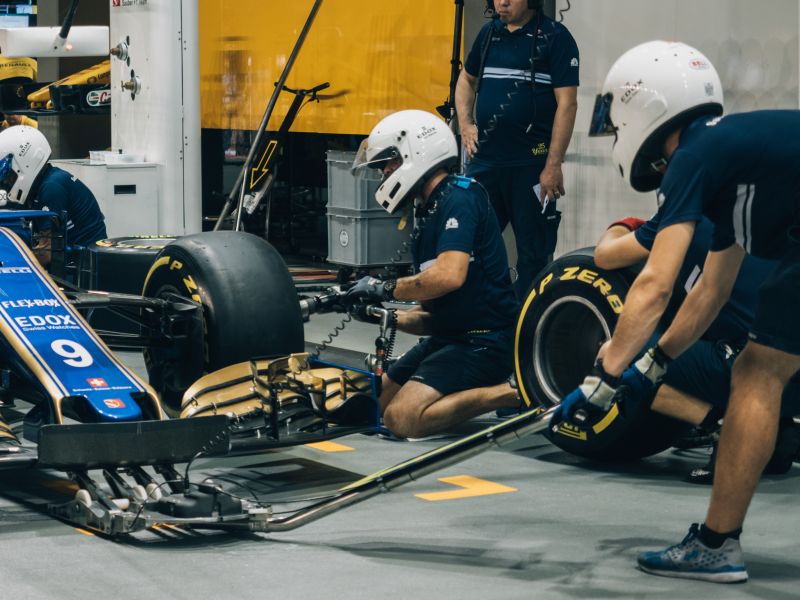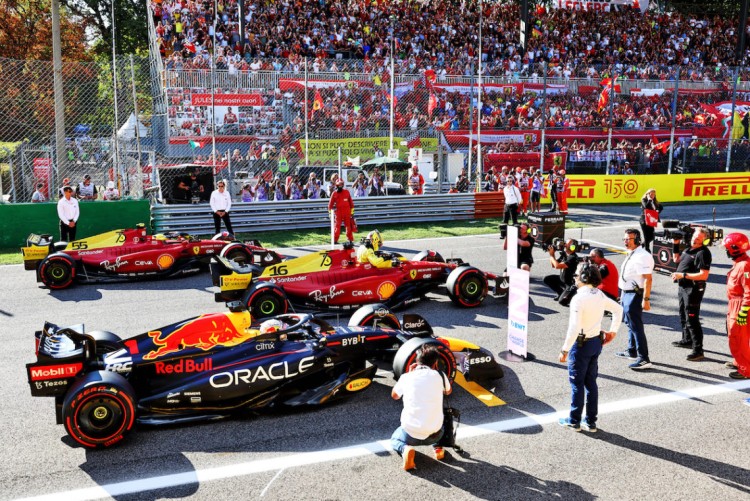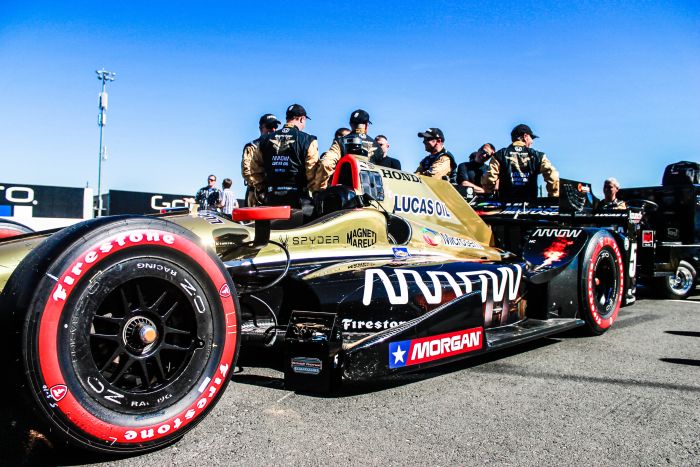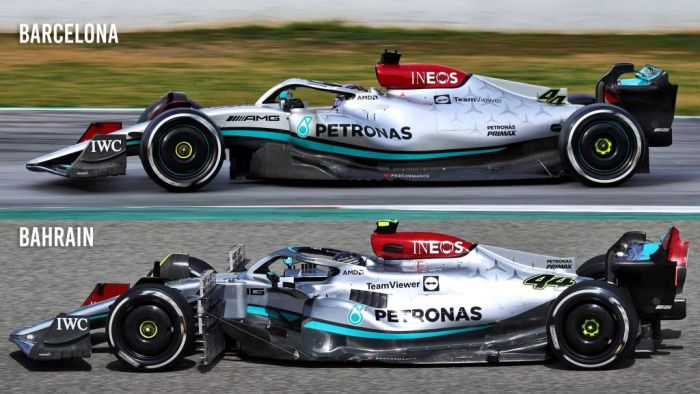
Due to the fact that the time it takes to develop every component—and, as a result, the total cost—can vary from team to team, determining the value of an F1 car is complicated by the fact that there are many moving pieces involved.
So, how much does a Formula 1 car cost? A Formula 1 car is pretty expensive, and it costs $12–15 million, depending on the team and how much they are willing and able to spend on building their F1 car.
Nevertheless, the 2022 Formula One rule changes have been meant to improve fair competition and make it possible for more racing teams to challenge Mercedes and Ferrari. Presently, several racing teams do have the resources to compete with Mercedes and Ferrari.
Table of Contents
What Is the Price of a Formula 1 Car?

| Car Part | Estimated Price in USD |
|---|---|
| Power Unit/Engine | $10.5 million |
| Monocoque/Chassis | $1.2 million |
| Fuel Tank | $150,000 |
| Gearbox | $600,000 |
| Front Wing with Nose Cone | $300,000 |
| Rear Wing and DRS Overtaking Aid | $150,000 |
| Steering Wheel | $50,000 |
| Transmission | $250,000 |
| Hydraulic System | $200,000 |
| Braking System | $35,000 |
| Driver’s Seat and Suspension | $53,000 |
| Tires | $2,000 |
| Total Material Expense | $13.490,000 |
You might have estimated that it was worth a couple of million dollars if you really extended your thinking. You would be mistaken by a wide margin if you did that.
Formula One teams must spend just over $14 million to construct a car from the ground up.
And this only accounts for the price of the primary parts of the typical Formula One car, as it is extremely challenging to calculate the price of the research and development that comes into the fabrication of these parts.
If you want to know How Much Horsepower Do F1 Cars Have? (DETAILED EXPLANATION), click here.
Why Are Formula 1 Cars so Expensive?
Manufacturers make an effort to conceal the overall price of developing a Formula One vehicle in order to prevent being penalized by the FIA (Fédération Internationale de l’Automobile), even though the primary parts of such a vehicle can add up to more than $14 million.
For instance, the FIA has imposed a limit of $15 million on the amount of money that can be spent on the engine of a Formula One car. However, the engine of the vehicle is comprised of more than just the engine block.
It also has 5 more parts that are considered to be auxiliary. When taken collectively, these parts are referred to as a power unit. Only the price of the engine block is disclosed by the manufacturers.
The process of analysis and improvement is one that is ongoing. Although the vehicles are now fighting in the 2022 season of Formula 1, engineers will be designing cars for the 2023 season of Formula 1 while they are still working on the 2022 season’s cars.
Research and development are also performed by companies that are creating road cars. However, a single model can account for hundreds of thousands of sales for the company. On the other hand, a Formula One team is only allowed to employ two cars for the entire season.
It has been projected that the top 3 teams would spend close to the cost maximum of $150 million in order to compete in 2023, whereas some of the lesser teams will still fight to achieve that point. It’s only reasonable that every team, no matter how big or how small, will seek to pay as much of this cost as they can through sponsorships.
The return of such a significant sum is only predicated on one factor: the level of success achieved by the team’s Formula One vehicle. Sometimes the best drivers in the world won’t be able to gain points in a Grand Prix if the efficiency of their cars isn’t up to par.
Alterations have also been made by the FIA to the regulations that control the costs that are incurred by the teams.
The regulations that were supposed to go into effect in 2021 but were delayed because of the impact of Covid-19 are going to be implemented in 2022 with the intention of drastically lowering the expenses of creating an F1 car and helping to even the competitive ground among the various companies.
The signature of the Concorde Agreement by all of the managers of racing teams will let more modestly funded teams battle more effectively against their more financially stable opponents.
If you want to know What Engines Do F1 Cars Use? (WHAT YOU DIDN’T KNOW!!!), click here.
What Are the Prices of the Various Parts of an F1 Car?
The FIA sets the standards for F1 cars, which are open-wheeled, open-cockpit, single-seat, rear-wheel-driven cars built for Formula One racing contests.
The chassis and the power unit are the two primary elements that make up the Formula One vehicle. The framework of the Formula One car is called the chassis, and all of the other components are connected to it.
If you want to know How Fast Is A Formula 1 Car? (DETAILED EXPLANATION), click here.
The engine is the most important component of the vehicle. It is responsible for producing power and will influence how quickly an F1 car can go while using the least amount of gasoline possible. The effectiveness of the power unit will frequently be the deciding factor in whether or not the team will be successful.
Note: There are many different parts and systems, including the front and rear wings, the monocoque, the gearbox, the steering wheel, hydraulic systems, control mechanisms, cooling systems, and more.
What Is the Price of an F1 Engine?
Since the 2014 Formula One season, all the race cars have been required to use turbocharged V6 engines with a displacement of 1600 cc.
Ever since time, the engines have undergone consistent development in order to extract the maximum amount of power possible from them. In point of fact, compared to the V8 engines that were utilized in the past, the ones installed in F1 cars now create more power while using less gasoline.
If you want to know What Are The Best F1 Simulators? (ON THE MARKET), click here.
An F1 vehicle engine is more than simply the engine block when it is discussed. The engine’s primary control mechanism and it.
There are 6 different parts that make up a power unit. 4 parts make up the whole: the internal combustion engine (ICE), the turbocharger (TC), the Motor Generator Unit-Kinetic (MGU-K), and the Motor Generator Unit-Heat (MGU-H). The elements are finished off by the Energy Store (ES), sometimes known as batteries, and Control Electronics (CE).
The power of the ICE is 700 horsepower, and it is achieved with the support of the TC by rotating at a total of 15000 revolutions per minute. Just 5 components of the power unit may be utilized by an F1 driver at any given time. The use of a 6th will result in the accrual of penalty points.
If you want to know What Do “Lapped” Cars Mean in F1? (DETAILED EXPLANATION), click here.
When the vehicle is going straight ahead and speeding, the MGU–K, which collects energy when the brakes are applied, and the MGU, which collects energy from the heat of the exhaust, both store energy in the ES, also known as the battery, and contribute an additional 300 horsepower.
Note: The driver of a Formula One car is generally allowed to operate 5 different elements of the power unit at any given moment.
In the event that somebody employs the 6th unit while competing in a Grand Prix, he will be subject to a penalty that will have an impact on the rankings of both the racers and the manufacturers.
The control electronics of a Formula One car allow the driver and his team to more effectively manage the approximately one thousand sensors that each send out millions of bytes of information.
If you want to know What Is the Top Speed of an F1 Car? (AMAZING!!!), click here.
Since the electronic control box and the exhaust box are only separated by a few millimeters, it is imperative that the wiring and electronic parts be shielded from the heat generated by the exhaust box.
Therefore, when we discuss how much it costs for an F1 vehicle engine, we are referring to the price of the Power Unit as opposed to the price of the internal combustion unit by itself. The price of a brand-new engine begins at a baseline of $11,000,000.
As a result of the enormous expenditures associated with competing in Formula One, engine makers like Cosworth are no longer a part of the sport. Reportedly, Ford has also exited the market for engine development as a result of the high costs associated with repairing their vehicles.
If you want to know How Much Does an F1 Pit Crew Member Earn? (INTERESTING FACTS), click here.
What Is the Price of a Formula One Vehicle Chassis?

The chassis is connected to all of the auxiliary pieces that make up the vehicle. It is a unibody construction that is put through a battery of tests to evaluate its tensile and shear strengths, as well as its stiffness and capacity to withstand pressures.
The chassis used in Formula One cars is called a monocoque, and it incorporates both the car and the driver’s protective shell. Monocoque chassis is nearly impossible to destroy, making them an excellent choice for vehicles that are driven in harsh environments.
If you want to know How Long Is a Formula One Season? (For The Fans), click here.
The monocoque is made out of a composite material that is made of carbon fiber and is five times lighter than steel despite being twice as durable. In most cases, it is constructed out of twelve layers of carbon fiber matting.
A monocoque made of carbon fiber can have a weight as low as 35 kg while yet being able to endure the huge stresses that are caused by aerodynamic forces and cornering velocities.
However, a monocoque chassis needs to be able to sustain the weight of the additional parts of the vehicle that are attached to it. The maximum legal weight for an F1 car, which includes the driver and the tires but does not take into account the amount of gasoline in the vehicle, is 633 kilograms.
If you want to know What Are F1 Grid Penalties? (DETAILED EXPLANATION), click here.
There is a possibility that purchasing a carbon fiber monocoque or chassis, in addition to the halo structure that provides protection for the driver, can cost a minimum of 1,200,000 dollars.
If you want to know Why Do F1 Cars Have Sidepods? (INTERESTING FACTS!!!), click here.
What Is the Price of a Formula 1 Gearbox?
In order to perform better, Formula 1 vehicles must utilize fully autonomous semi-automatic seamless shift gearboxes, which raises the price of the gearboxes. These gearboxes must have 8 forward gears and a single reverse gear.
The gearbox and the set of gears are linked together by a differential. The power is transferred to the rear wheels, which are what really propel the vehicle, through a drive shaft.
Shifting gears in Formula One cars is done with the help of “flappy paddles,” which are positioned on the bottom of the steering wheel.
It is estimated that the cost of a gearbox for an F1 car could be $600,000. The maximum cost of the gearbox may change depending on the characteristics of the driver and the construction of the vehicle.
What Are the Prices of an F1 Car’s Front and Rear Wings?

During a Grand Prix, Formula One cars may reach speeds of up to 300 kilometers per hour, which is faster than the speed at which light airplanes can take off.
If the vehicle were traveling at that speed, it would have relatively little hold on the asphalt, and the drivers would be unable to maintain the vehicle’s control in the absence of a rear or front wing as an integral component of the standard body frame.
If you want to know Why Are F1 Cars Getting Bigger? (WHAT YOU DIDN’T KNOW), click here.
Simultaneously, automobiles moving at such velocities or greater would face a significant amount of drag because of the force of the wind. Because of this drag, both the cars’ speed and their fuel usage would be impacted.
It is primarily the front and rear wings of the vehicle that are responsible for creating the downforce that is necessary to keep the vehicle firmly planted on the track and enable it to reach high speeds.
Note: The air is guided away from the front tires and around the car by the front wing, because it is the most prominent portion of the vehicle and, in conjunction with the nose cone, is responsible for directing the wing.
Additionally, it is constructed to point downwards, which has the effect of providing an effect that is analogous to the contrary of what is produced by the wings of an airplane and results in an increase in the car’s downforce.
This arrangement of the front wing provides downforce. The design process for the nose cone and the front wings occurs simultaneously.
Both the turbulence and the drag caused by the car’s wake are mitigated by the rear wing, which also contributes to the vehicle’s ability to generate downforce. In addition to that, it comes with the DRS overtaking aid.
The rear wing of the vehicle not only contributes to the overall downforce but also lowers the amount of air resistance experienced by the vehicle. Additionally, it contributes to the preservation of the vehicle’s stability.
If you want to know What is Formula 1 DRS? (THINGS YOU DIDN’T KNOW), click here.
During a race, if a car loses its rear wing, it will lose nearly all of the downforce it generates and will become very difficult to control.
An F1 car is capable of producing a downforce of up to 5G while it is traveling at its top speed. That indicates that there is a force equal to five times the weight of the car pressing down on the asphalt.
Note: Because of this, the car is able to get a stronger hold on the track, and it also avoids losing grip when it is turning. The driver has the ability to adjust the level of downforce by adjusting the alignment of the wings using the steering wheel.
The price of a Formula One car’s front wings and nose cone combined will be $300,000, whereas the price of the car’s rear wing will be approximately $150,000. This represents an estimate of the expense, which may be more or lower depending on the particulars of the wings.
What Is the Price of a Formula 1 Steering Wheel?
Carbon fiber is used in the construction of F1 steering wheels, and silicone is used for the grips. The driver has complete command over all aspects of the vehicle thanks to a comprehensive set of control buttons and a graphical display.
It is not possible for the driver to exit or enter the cockpit without first removing the specialized steering wheels from their attachments on the steering column.
The steering wheel must be able to be detached from the column and reattached in fewer than five seconds if the driver is to be successful.
If you want to know What’s the Difference Between IndyCar and F1? (YOU DIDN’T KNOW), click here.
A specialized connector is incorporated into the column of the steering wheel in order to facilitate the connection of the steering wiring to the vehicle’s main wiring.
There is no possibility of the connectors becoming misaligned when the male connector of the primary automobile wiring is inserted into the connector for the column.
When compared to a streetcar, drivers of automobiles are required to change through the 4th gear in order to move from the 5th gear to the 3rd gear.
When moving forward from a stop, the clutch, which is located on the bottom right side of the underside of the steering wheel, is engaged.
Additionally, there is a neutral button located right above the upshifting pedal on the left side of the vehicle. This switch needs to be pressed by the driver before the gear may be moved into neutral.
In addition to the gear-shift paddles, the steering wheel features an infinite number of switches, and a color screen is mounted in the middle to provide drivers with a visual display.
The wheel of a Formula One car is generally rectangular in design and has rounded sides, in contrast to the wheel of a street car. The rectangle’s controls consist of dials at the bottom, a central screen, and switches that are arranged around the rectangle’s center.
In addition to shifting gears, the majority of drivers have control over more than 40 different operations located all across the vehicle.
The cost of a Formula 1 steering wheel is approximately $70,000.
What Is the Price of a Formula 1 Fuel Tank?
In the history of Formula One racing, there have been a significant number of deadly incidents caused by the rupture of gasoline tanks and the subsequent ignition of the fuel, which has resulted in the loss of many participants’ lives.
The fuel tanks used in Formula One races today are virtually unbreakable, and teams are no longer needed to stop and replenish throughout the course of a race. This serves to reduce the risk of catastrophic fire damage.
Kevlar and polyurethane are the two materials that are used to make the fuel tanks of today’s Formula One cars. They are positioned in the area between the driver’s seat and the engine in the vehicle.
The ribbed and contoured fuel bags, if that’s what you want to call them, are designed to fit into the empty space behind the driver’s seat. As the fuel is drained from them, they are secured to the back of the driver’s seat so that they do not collapse.
According to the regulations set forth by the FIA, the gas tank of an F1 car can only hold a maximum of 110 liters. To maintain a low center of gravity throughout the vehicle, the gasoline tank is broader at the bottom than it is anywhere else.
The price of a brand-new petrol tank that is made to fit in the area behind the driver’s seat is approximately $150,000, with a significant portion of the expense of the fuel tank getting absorbed by the price of the kevlar.
What Is the Price of a Set of Tires for an F1 Car?

Formula 1 vehicle tires only last for about 120 kilometers, in contrast to street car tires, which can survive for more than 7,000 kilometers. After reaching the maximal limit of tire deterioration, racecar drivers make pit stops throughout the competition to replace the tires on their vehicles.
Tires used in Formula One are available in a variety of hardnesses, allowing drivers to adapt their performance to the demands of each track and the elements. Tires that are hard and slick are ideal for usage by drivers when the conditions are dry and the circuit has a decent grip.
In order to avoid aquaplaning when the roads are wet, it is best to have tires that are both soft and treaded. Treaded tires are utilized for driving in wet circumstances and are categorized as intermediate when driving through light standing water and as wet when driving through severe standing water.
Slick tires, which are designed to be used in dry circumstances, come in three distinct hardnesses: hard, medium, and soft. Tires can be constructed from a variety of compositions.
The whole field of Formula One teams that will compete in the 2023 season will receive their tires from the official supplier, Pirelli. The team will incur a cost of $2,000 for each new set of tires.
Additionally, there is the expensive cooling system, driver’s seat, and suspension, all of which add up to a significant financial investment.
What Is the Price of an F1 Car’s Hydraulic System?
An F1 car’s 9 individual subsystems are managed by a sophisticated hydraulic control system. The number of errors that are possible for a driver to commit has decreased as a result of the development of modern hydraulics.
Thanks to the hydraulic system, the steering can be power-driven, and it is possible to install a clutch that can be changed manually on the steering wheel.
Additionally, by having a switch mounted on the steering wheel, the hydraulic control system enabled the driver to manually change gears when necessary.
Note: Since the DRS system is hydraulically powered, the driver can also operate it from the steering wheel.
The sophistication of a system tends to go hand in hand with an increase in the expense of putting it into operation. In exchange, you will receive performance, convenience, and true control over the situation.
At a bare minimum, a hydraulic system for an F1 car costs $200,000.
Why Do Formula 1 Vehicles Cost so Much?
How much does it cost to buy a Formula One car? To put it into perspective, the parts of a typical Formula One car cost 14 million dollars.
Meanwhile, the excellent thing is that, as a result of the FIA Technical Regulations, the fuel that is employed in an F1 car is required to be comparable to the fuel that is purchased at gas stations by the general public.
Racing teams keep the information regarding the price of an F1 car a well-guarded secret. This is not just due to the nature of the rivalry, but also to the fact that the FIA places a cap on the amount of money that may be spent.
For the course of the season, teams will upgrade various components, and significant damage caused by even a single error can drive up prices during the global championship.
It is extremely difficult, if not impossible, to calculate the number of man-hours that are spent on the investigation, design, and testing of each significant part of the automobile. Because of this, it is difficult to estimate an accurate price of a Formula One car.
Conclusion
A Formula 1 car is pretty expensive since it is made of pretty expensive materials, and it is interesting how slight differences can have a great effect on a car’s price.
